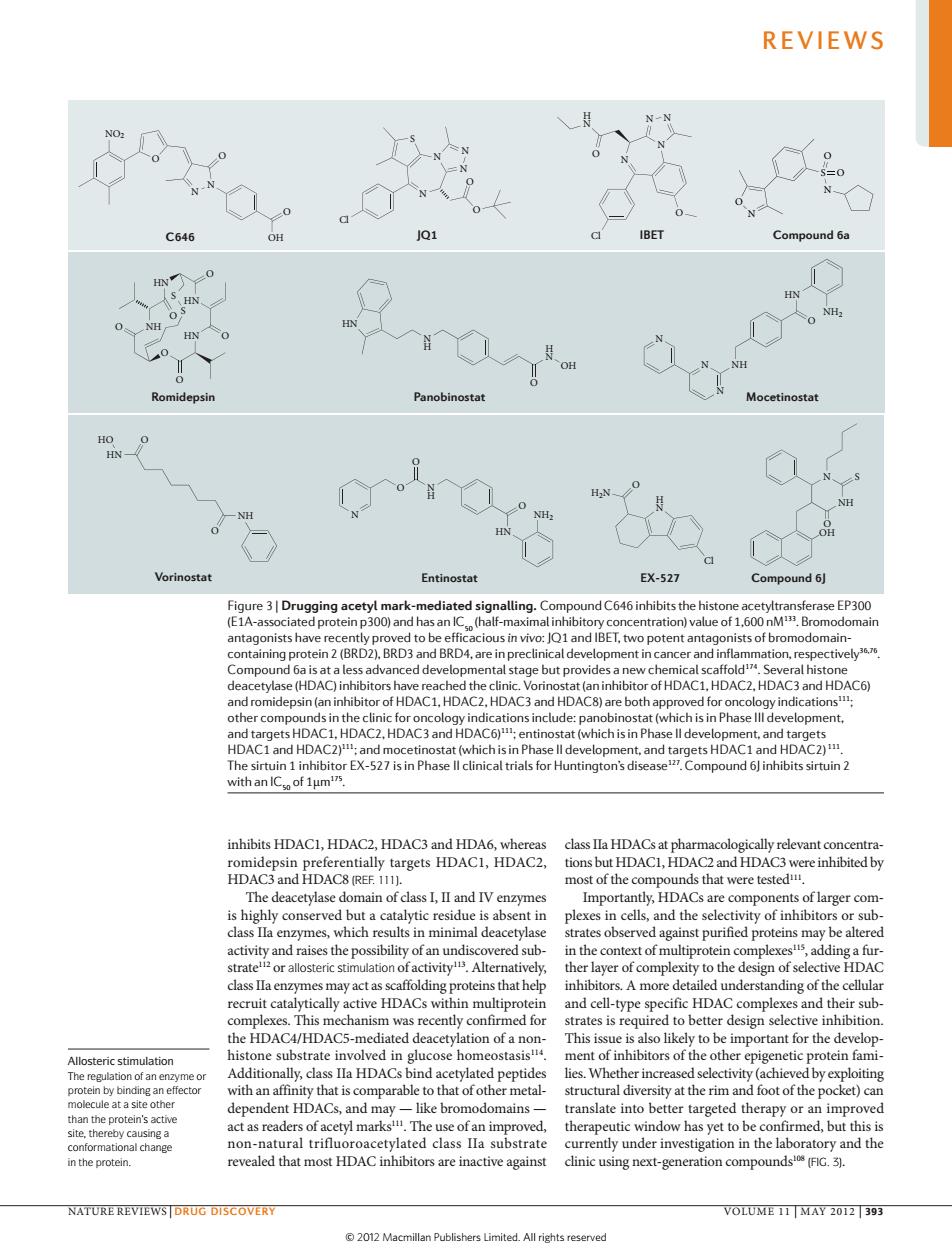正在加载图片...

REVIEWS NO: 9 d C646 HN 0 NH HN Entinosta EX-527 re ugging acetyl mark-mediated signalling.Con ound C646 inhibits the hist cts hav BEiwopOtenta C6 d f .HDAC3 and HDAC with anICof1μm inhibits HDACI, HDAC2,HDAC HDACI,HDAC2. most of the compoun is class Ila enzymes,which results in minimal deacetylase strates observed against purified proteins may be altere ors.A more detailed understanding of the cellular he HDAC4/HDAC5-mediated deacetylation ofanon c stimulation Additionally.class na HDACs bind acetvlated peptide lies wheth d selectivity (achie netal- act as readers marksl The e ofan im ved. thera cuticwindowha et to be c non-nat ural triflu under investigation in the oratory and the NATURE REVIEWS DRUG DISCOVERY VOLUME 11 MAY 2012 393Nature Reviews | Drug Discovery N H N O N N O N Cl N H H N OH O HN NH HN HO O O N N N NH HN NH2 O C646 JQ1 IBET Compound 6a Panobinostat Vorinostat Mocetinostat O N N Cl S N N O O N O OH O N N O N H O HN O NH2 H N H2N O Cl OH O NH N S Romidepsin Entinostat EX-527 Compound 6J HN HN O O O NH O O S S HN O NO2 S N O O O N Allosteric stimulation The regulation of an enzyme or protein by binding an effector molecule at a site other than the protein’s active site, thereby causing a conformational change in the protein. inhibits HDAC1, HDAC2, HDAC3 and HDA6, whereas romidepsin preferentially targets HDAC1, HDAC2, HDAC3 and HDAC8 (REF. 111). The deacetylase domain of class I, II and IV enzymes is highly conserved but a catalytic residue is absent in class IIa enzymes, which results in minimal deacetylase activity and raises the possibility of an undiscovered substrate112 or allosteric stimulation of activity113. Alternatively, class IIa enzymes may act as scaffolding proteins that help recruit catalytically active HDACs within multiprotein complexes. This mechanism was recently confirmed for the HDAC4/HDAC5-mediated deacetylation of a nonhistone substrate involved in glucose homeostasis114. Additionally, class IIa HDACs bind acetylated peptides with an affinity that is comparable to that of other metaldependent HDACs, and may — like bromodomains — act as readers of acetyl marks111. The use of an improved, non-natural trifluoroacetylated class IIa substrate revealed that most HDAC inhibitors are inactive against class IIa HDACs at pharmacologically relevant concentrations but HDAC1, HDAC2 and HDAC3 were inhibited by most of the compounds that were tested111. Importantly, HDACs are components of larger complexes in cells, and the selectivity of inhibitors or substrates observed against purified proteins may be altered in the context of multiprotein complexes115, adding a further layer of complexity to the design of selective HDAC inhibitors. A more detailed understanding of the cellular and cell-type specific HDAC complexes and their substrates is required to better design selective inhibition. This issue is also likely to be important for the development of inhibitors of the other epigenetic protein families. Whether increased selectivity (achieved by exploiting structural diversity at the rim and foot of the pocket) can translate into better targeted therapy or an improved therapeutic window has yet to be confirmed, but this is currently under investigation in the laboratory and the clinic using next-generation compounds108 (FIG. 3). Figure 3 | Drugging acetyl mark-mediated signalling. Compound C646 inhibits the histone acetyltransferase EP300 (E1A-associated protein p300) and has an IC50 (half-maximal inhibitory concentration) value of 1,600 nM133. Bromodomain antagonists have recently proved to be efficacious in vivo: JQ1 and IBET, two potent antagonists of bromodomaincontaining protein 2 (BRD2), BRD3 and BRD4, are in preclinical development in cancer and inflammation, respectively36,76. Compound 6a is at a less advanced developmental stage but provides a new chemical scaffold174. Several histone deacetylase (HDAC) inhibitors have reached the clinic. Vorinostat (an inhibitor of HDAC1, HDAC2, HDAC3 and HDAC6) and romidepsin (an inhibitor of HDAC1, HDAC2, HDAC3 and HDAC8) are both approved for oncology indications111; other compounds in the clinic for oncology indications include: panobinostat (which is in Phase III development, and targets HDAC1, HDAC2, HDAC3 and HDAC6)111; entinostat (which is in Phase II development, and targets HDAC1 and HDAC2)111; and mocetinostat (which is in Phase II development, and targets HDAC1 and HDAC2) 111. The sirtuin 1 inhibitor EX‑527 is in Phase II clinical trials for Huntington’s disease127. Compound 6J inhibits sirtuin 2 with an IC50 of 1μm175. REVIEWS NATURE REVIEWS | DRUG DISCOVERY VOLUME 11 | MAY 2012 | 393 © 2012 Macmillan Publishers Limited. All rights reserved